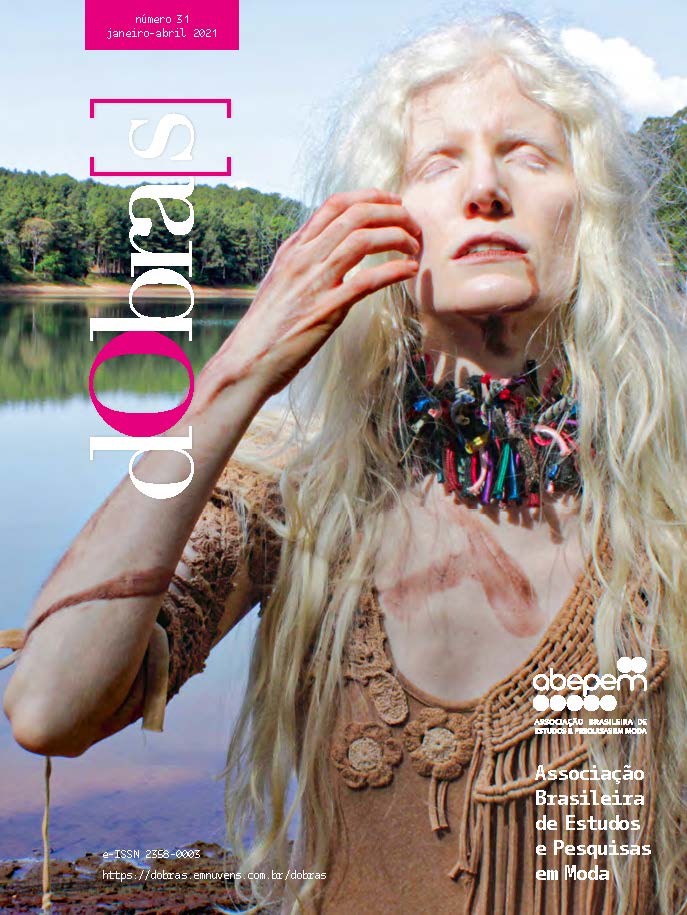Lustro, laca e Liotard
técnicas e texturas entre Ásia e Europa
DOI:
https://doi.org/10.26563/dobras.i31.1308Palavras-chave:
História da Arte, Tecnologia, Iluminismo, Chinoiserie, Conexões históricasResumo
Com a ajuda de exemplos provenientes dos domínios das artes decorativas e das belas-artes, mostramos que o brilho das superfícies se torna um dos objetivos maiores da economia das chinoiseries. Os artesãos e artistas suíços tinham conhecimento das porcelanas, das lacas e dos tecidos que se difundiram por toda a Europa, e sua circulação estava ligada às ambições diplomáticas e econômicas dos países envolvidos (China, Japão, Sião, França, Alemanha, Inglaterra, Holanda...). No continente é, portanto, uma questão de dominar essas técnicas para desenvolvê-las e comercializá-las. Além disso, os atores procuram traduzir o brilho e a textura em diferentes meios: os objetos importados da China ou do Japão transformam desse modo o universo sensorial europeu, estimulando a imitação de certas matérias e resultados plásticos, como o brilho e o perolado. Por exemplo, na natureza morta da coleção Getty, o pintor genebrino Jean-Etienne Liotard é diretamente confrontado com as propriedades materiais e formais das lacas asiáticas, introduzindo um novo horizonte visual e tátil na Europa.
Downloads
Referências
AVCIOGLU, Nebahat. Turquerie and the politics of representation, 1728-1876. Farnham: Ashgate Publ., 2011.
BEHN, Aphra. Oroonoko or the royal slave. A true history. London: William Canning, 1688.
BOERLIN-BRODBECK, Yvonne. Chinoiserie in der deutschsprachigen Schweiz. In: HUGGER, Paul. (ed.) China in der Schweiz: Zwei Kulturen im Kontakt. Zürich: Offizin, 2005. p. 27-40.
CASTELLUCIO, Stéphane. Le prince et le marchand. Le commerce de luxe chez les marchands merciers parisiens pendant le règne de Louis XIV. Paris: Éditions SPM, 2014.
DUCRET, Sigfried. Die Zürcher Porzellanmanufaktur und ihre Erzeugnisse im 18. und 19. Jahrhundert. Bd. I. Zürich: Orell Fussli Verlag, 1959.
ETIENNE, Noémie. Paris. 1750-1815. Practice, discourse, materiality. Los Angeles: GCI Publications, 2017.
ETIENNE, Noémie; CHENAL, Vincent. Les demoiselles Rath et l’institution artistique à Genève autour de 1800. In: BERNARDI, Donatella. Post Tenebras Luxe. Catalogue d’exposition. (Genève, Musée Rath, du 28 août au 27 septembre 2009), Genève, Labor et Fides, 2009. p. 67-87.
FORRAY-CARLIER, Anne; KOPPLIN, Monika (ed.). Les secrets de la laque française. Le vernis Martin. Catalogue de l’exposition. (Paris: Les Arts Décoratifs, du 13 février 2014 au 8 juin), 2014.
GITTINGER, Mattiebelle. Master dyers to the world: technique and trade in early indian dyed cotton textiles. Washington: The Textile Museum, 1982.
GRUBER, Alain. Chinoiserie: Der Einfluss Chinas auf die europäische Kunst 17-19 Jahrhundert. Ausstellungskatalog Abegg-Stiftung. Bern: Riggisberger Berichte, 1984.
HUGGER, Paul. (ed.) China in der Schweiz: Zwei Kulturen im Kontakt. Zürich: Offizin Verlag, 2005.
JACKSON, Anna; JAFFER, Amin. (eds.) Encounters. The Meeting of Asia and Europe, 1500- 1800. London: Victoria & Albert Museum, 2004.
JAUCOURT, Chevalier de. Vernis du Japon. In: DIDEROT, Denis; D’ Alembert, Jean (eds.) Encyclopédie ou dictionnaire raisonné des sciences, des arts et des métiers. V. 17. Paris, 1765, p. 77.
JOLLY, Anna (ed.) A taste for the exotic. Foreign influences on early Eighteenth-Century silk designs (Riggisberger Berichte 14). Bern: Riggisberger Berichte, 2007.
KOOS, Marianne. Haut, Farbe und Medialität. Ober fläche im Werk von Jean-Etienne Liotard. München: Wilhelm Fink Paderborn, 2014.
KOPPLIN, Monika. Europäische Lackkunst. Ausgewählte Arbeiten. Durchgehend, meist farbig bebildert. Münster: Museum für Lackkunst, 1998.
LIOTARD, Jean-Etienne. Traité des principes et des règles de la peinture. Genf, 1781.
MARTIN, Meredith. Mirror Reflections: Louis XIV, Phra Narai, and the Material Culture of Kingship. Art History, London, n. 38, 2015, p. 652-667. DOI: 10.1111/1467-8365.12173.
ROETHLISBERGER, MARCEL. Jean-Etienne Liotard as a Painter of Still Lifes. The J. Paul Getty Museum Journal, Los Angeles, n. 13, 1985, p. 109-120.
SCHMIDT, Benjamin. Inventing Exoticism: Geography, Globalism, and Europe’s Early Modern World. Philadelphia: University of Pennsylvania Press, 2015.
SHERIFF, Mary D. (org.). Cultural contact and the making of European Art since the age of exploration. Chapel Hill: The University of North Carolina Press, 2010.
SLOBODA, Stacey. Chinoiserie. Commerce and critical ornament in Eighteenth-Century britain. Manchester: Manchester University Press, 2014.
SMENTEK, Kristel. Looking East: Jean-Etienne Liotard, the Turkish Painter. In: AVCIOGLU, Nebahat; FLOOD, Barry (org.). Globalizing culture: art and mobility in the Eighteenth Century. Ars Orientalis. Smithsonian Institution: Washington, 2010, p. 84-112.
STAZAK, Jean-François. Qu’est-ce que l’exotisme? Le Globe. Revue genevoise de géographie, LOCAL, n. 148, 2008, p. 7-30.
VOIRET, Jean-Pierre. Genf und die Verbreitung der Chinoiserie in der Schweiz. In: HUGGER, Paul (ed.) China in der Schweiz: Zwei Kulturen im Kontakt. Zürich: Offizin, 2005. p. 12-26.
YONAN, Michael. Empress Maria Theresa and the politics of Habsburg Imperial Art. Philadelphia: Penn State University Press, 2011.










